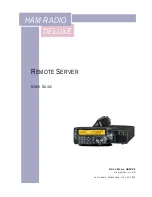
Resolving suspected power problems
Power problems can be difficult to solve. For example, a short circuit can exist anywhere on any of the power
distribution buses. Usually, a short circuit will cause the power subsystem to shut down because of an
overcurrent condition.
Complete the following steps to diagnose and resolve a suspected power problem.
Step 1. Check for short circuits, for example, if a loose screw causes short circuit on a circuit board.
Step 2. Remove the adapters and disconnect the cables and power cords to all internal and external
devices until the server is at the minimum configuration that is required for the server to start. The
minimum configuration required for the server is as the following:
• One processor
• One 8 GB ECC UDIMM in slot 1
• One power supply
• One 3.5-inch drive in drive bay 1
• Power cord
• One system front fan
Step 3. Reconnect all AC power cords and turn on the server. If the server starts successfully, reseat the
adapters and devices one at a time until the problem is isolated.
If the server does not start from the minimum configuration, replace the components in the minimum
configuration one at a time until the problem is isolated.
Resolving suspected Ethernet controller problems
The method that you use to test the Ethernet controller depends on which operating system you are using.
See the operating-system documentation for information about Ethernet controllers, and see the Ethernet
controller device-driver readme file.
Complete the following steps to try to resolve suspected problems with the Ethernet controller.
Step 1. Make sure that the correct device drivers which come with the server are installed, and that they
are at the latest level.
Step 2. Make sure that the Ethernet cable is installed correctly.
• The cable must be securely attached at all connections. If the cable is attached but the problem
remains, try a different cable.
• If you set the Ethernet controller to operate at 100 Mbps or 1000 Mbps, you must use Category
5 cabling.
Step 3. Determine whether the hub supports auto-negotiation. If it does not, try configuring the integrated
Ethernet controller manually to match the speed and duplex mode of the hub.
Step 4. Check the Ethernet controller LEDs on the rear panel of the server. These LEDs indicate whether
there is a problem with the connector, cable, or hub.
• The Ethernet link status LED is lit when the Ethernet controller receives a link pulse from the hub.
If the LED is off, there might be a defective connector or cable or a problem with the hub.
• The Ethernet transmit/receive activity LED is lit when the Ethernet controller sends or receives
data over the Ethernet network. If the Ethernet transmit/receive activity is off, make sure that the
hub and network are operating and that the correct device drivers are installed.
Step 5. Check for operating-system-specific causes of the problem, and also make sure that the operating
system drivers are installed correctly.
Step 6. Make sure that the device drivers on the client and server are using the same protocol.
163
Содержание ThinkSystem ST50 V2
Страница 1: ...ThinkSystem ST50 V2 Maintenance Manual Machine Types 7D8J and 7D8K ...
Страница 8: ...vi ThinkSystem ST50 V2 Maintenance Manual ...
Страница 48: ...40 ThinkSystem ST50 V2 Maintenance Manual ...
Страница 122: ...114 ThinkSystem ST50 V2 Maintenance Manual ...
Страница 182: ...174 ThinkSystem ST50 V2 Maintenance Manual ...
Страница 190: ...182 ThinkSystem ST50 V2 Maintenance Manual ...
Страница 191: ......
Страница 192: ......
















































